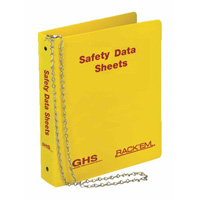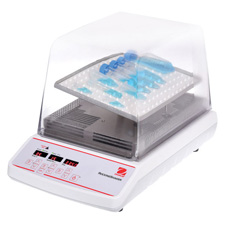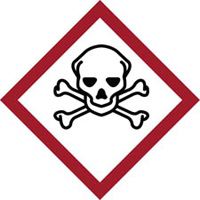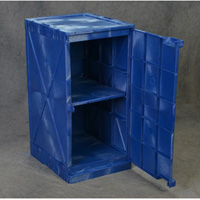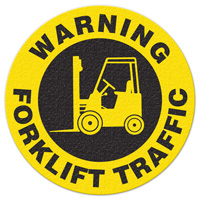| The Home page of ILPI's Safety Data Sheet (SDS) Resource, the leader in SDS information since 1995! | |
| The history and philosophy behind this resource. | |
| A curated collection of books and reference materials concerning Safety Data Sheets and closely related topics. | |
| Paste your plain text SDS into the SDS-Demystifier, and it will be converted into a hypertext-enriched document with links to detailed explanations of each key term. | |
| An extensive list of frequently asked questions about Safety Data Sheets including regulations, content, compliance, and more. | |
| A humorous take on Safety Data Sheet jargon. Fill in the blanks on our entry form to generate a personalized Unsafety Data Sheet to share with your coworkers. | |
| Since 1995, we've maintained this massive curated list of the best places to find Safety Data Sheets on the Internet. | |
| Way more than a glossary, this hypertext-enhanced resource covers hundreds of SDS-related terms and expert knowledge. Each entry includes both the SDS relevance and links to additional authoritative resources. | |
| Archived results of Safety Data Sheet related polls taken by some of our millions of site visitors | |
| You are here! The OSHA regulations behind SDS regulations, including the inspection guidelines and over 400 official interpretations letters under the Hazard Communication Standard | |
| Commercial suppliers of SDS authoring and management software as well as cloud compliance services. | |
| Commercial companies that will create SDS's for your specific needs as well as SDS translation companies. |

Safety signs, banners, and scoreboards? Get yours at Safety Emporium!
The OSHA Hazard Communication Standard (HCS)
(Subpart Z, Toxic and Hazardous Substances, 29 CFR 1910.1200)
(Roll cursor over section to see description)
- Purpose
- Scope and Application
- Definitions
- Hazard classification
- Written Hazard Communication Program Classification
- Labels And Other Forms of Warning
- Safety Data Sheets
- Employee Information and Training
- Trade Secrets
- Effective Dates
- Appendix A - Health Hazard Criteria (Mandatory)
- Appendix B - Physical Criteria (Mandatory)
- Appendix C - Allocation Of Label Elements (Mandatory)
- Appendix D - Safety Data Sheets (Mandatory)
- Appendix E - Definition of "Trade Secret" (Mandatory)
- Appendix F - Guidance for hazard classifications Re: Carcinogenicity (Non-Mandatory)
Note: This version became effective May 25, 2012 and replaces the previous version of the Hazard Communication Standard.
(a)(1)
The purpose of this section is to ensure that the hazards of all chemicals produced or imported are classified, and that information concerning the classified hazards is transmitted to employers and employees. The requirements of this section are intended to be consistent with the provisions of the United Nations Globally Harmonized System of Classification and Labeling of Chemicals (GHS), Revision 3. The transmittal of information is to be accomplished by means of comprehensive hazard communication programs, which are to include container labeling and other forms of warning, safety data sheets and employee training.
(a)(2)
This occupational safety and health standard is intended to address comprehensively the issue of classifying the potential hazards of chemicals, and communicating information concerning hazards and appropriate protective measures to employees, and to preempt any legislative or regulatory enactments of a state, or political subdivision of a state, pertaining to this subject. Classifying the potential hazards of chemicals and communicating information concerning hazards and appropriate protective measures to employees, may include, for example, but is not limited to, provisions for: developing and maintaining a written hazard communication program for the workplace, including lists of hazardous chemicals present; labeling of containers of chemicals in the workplace, as well as of containers of chemicals being shipped to other workplaces; preparation and distribution of safety data sheets to employees and downstream employers; and development and implementation of employee training programs regarding hazards of chemicals and protective measures. Under section 18 of the Act, no state or political subdivision of a state may adopt or enforce any requirement relating to the issue addressed by this Federal standard, except pursuant to a Federally-approved state plan.
[Beginning of This Section] [Top of this page]
For further information see:
CPL 02-02-079, Inspection Procedures for the Hazard Communication Standard (HCS 2012)
(b)(1)
This section requires chemical manufacturers or importers to classify the hazards of chemicals which they produce or import, and all employers to provide information to their employees about the hazardous chemicals to which they are exposed, by means of a hazard communication program, labels and other forms of warning, safety data sheets, and information and training. In addition, this section requires distributors to transmit the required information to employers. (Employers who do not produce or import chemicals need only focus on those parts of this rule that deal with establishing a workplace program and communicating information to their workers.)
(b)(2)
This section applies to any chemical which is known to be present in the workplace in such a manner that employees may be exposed under normal conditions of use or in a foreseeable emergency.
(b)(3)
This section applies to laboratories only as follows:
(b)(3)(i)
Employers shall ensure that labels on incoming containers of hazardous chemicals are not removed or defaced;
(b)(3)(ii)
Employers shall maintain any safety data sheets that are received with incoming shipments of hazardous chemicals, and ensure that they are readily accessible during each workshift to laboratory employees when they are in their work areas;
(b)(3)(iii)
Employers shall ensure that laboratory employees are provided information and training in accordance with paragraph (h) of this section, except for the location and availability of the written hazard communication program under paragraph (h)(2)(iii) of this section; and,
(b)(3)(iv)
Laboratory employers that ship hazardous chemicals are considered to be either a chemical manufacturer or a distributor under this rule, and thus must ensure that any containers of hazardous chemicals leaving the laboratory are labeled in accordance with paragraph (f) of this section, and that a safety data sheets is provided to distributors and other employers in accordance with paragraphs (g)(6) and (g)(7) of this section.
(b)(4)
In work operations where employees only handle chemicals in sealed containers which are not opened under normal conditions of use (such as are found in marine cargo handling, warehousing, or retail sales), this section applies to these operations only as follows:
(b)(4)(i)
Employers shall ensure that labels on incoming containers of hazardous chemicals are not removed or defaced;
(b)(4)(ii)
Employers shall maintain copies of any safety data sheets that are received with incoming shipments of the sealed containers of hazardous chemicals, shall obtain a safety data sheet as soon as possible for sealed containers of hazardous chemicals received without a safety data sheet if an employee requests the safety data sheet, and shall ensure that the safety data sheets are readily accessible during each work shift to employees when they are in their work area(s); and,
(b)(4)(iii)
Employers shall ensure that employees are provided with information and training in accordance with paragraph (h) of this section (except for the location and availability of the written hazard communication program under paragraph (h)(2)(iii) of this section), to the extent necessary to protect them in the event of a spill or leak of a hazardous chemical from a sealed container.
(b)(5)
This section does not require labeling of the following chemicals:
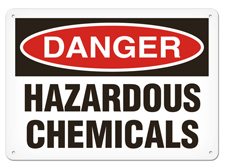
Ensure a safe workplace with safety signs and labels from Safety Emporium!
(b)(5)(i)
Any pesticide as such term is defined in the Federal Insecticide, Fungicide, and Rodenticide Act (7 U.S.C. 136 et seq.), when subject to the labeling requirements of that Act and labeling regulations issued under that Act by the Environmental Protection Agency;
(b)(5)(ii)
Any chemical substance or mixture as such terms are defined in the Toxic Substances Control Act (15 U.S.C. 2601 et seq.), when subject to the labeling requirements of that Act and labeling regulations issued under that Act by the Environmental Protection Agency;
(b)(5)(iii)
Any food, food additive, color additive, drug, cosmetic, or medical or veterinary device or product, including materials intended for use as ingredients in such products (e.g. flavors and fragrances), as such terms are defined in the Federal Food, Drug, and Cosmetic Act (21 U.S.C. 301 et seq.) or the Virus-Serum-Toxin Act of 1913 (21 U.S.C. 151 et seq.), and regulations issued under those Acts, when they are subject to the labeling requirements under those Acts by either the Food and Drug Administration or the Department of Agriculture;
(b)(5)(iv)
Any distilled spirits (beverage alcohols), wine, or malt beverage intended for nonindustrial use, as such terms are defined in the Federal Alcohol Administration Act (27 U.S.C. 201 et seq.) and regulations issued under that Act, when subject to the labeling requirements of that Act and labeling regulations issued under that Act by the Bureau of Alcohol, Tobacco, Firearms and Explosives;
(b)(5)(v)
Any consumer product or hazardous substance as those terms are defined in the Consumer Product Safety Act (15 U.S.C. 2051 et seq.) and Federal Hazardous Substances Act (15 U.S.C. 1261 et seq.) respectively, when subject to a consumer product safety standard or labeling requirement of those Acts, or regulations issued under those Acts by the Consumer Product Safety Commission; and,
(b)(5)(vi)
Agricultural or vegetable seed treated with pesticides and labeled in accordance with the Federal Seed Act (7 U.S.C. 1551 et seq.) and the labeling regulations issued under that Act by the Department of Agriculture.
(b)(6)
This section does not apply to:
(b)(6)(i)
Any hazardous waste as such term is defined by the Solid Waste Disposal Act, as amended by the Resource Conservation and Recovery Act of 1976, as amended (42 U.S.C. 6901 et seq.), when subject to regulations issued under that Act by the Environmental Protection Agency;
(b)(6)(ii)
Any hazardous substance as such term is defined by the Comprehensive Environmental Response, Compensation and Liability Act (CERCLA) (42 U.S.C. 9601 et seq.) when the hazardous substance is the focus of remedial or removal action being conducted under CERCLA in accordance with Environmental Protection Agency regulations.
(b)(6)(iii)
(b)(6)(iv)
Wood or wood products, including lumber which will not be processed, where the chemical manufacturer or importer can establish that the only hazard they pose to employees is the potential for flammability or combustibility (wood or wood products which have been treated with a hazardous chemical covered by this standard, and wood which may be subsequently sawed or cut, generating dust, are not exempted);
(b)(6)(v)
Articles (as that term is defined in paragraph (c) of this section); regulations.
(b)(6)(vi)
Food or alcoholic beverages which are sold, used, or prepared in a retail establishment (such as a grocery store, restaurant, or drinking place), and foods intended for personal consumption by employees while in the workplace;
(b)(6)(vii)
Any drug, as that term is defined in the Federal Food, Drug, and Cosmetic Act (21 U.S.C. 301 et seq.), when it is in solid, final form for direct administration to the patient (e.g., tablets or pills); drugs which are packaged by the chemical manufacturer for sale to consumers in a retail establishment (e.g., over-the-counter drugs); and drugs intended for personal consumption by employees while in the workplace (e.g., first aid supplies);
(b)(6)(viii)
Cosmetics which are packaged for sale to consumers in a retail establishment, and cosmetics intended for personal consumption by employees while in the workplace;
(b)(6)(ix)
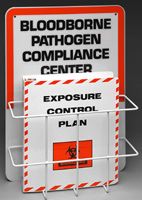
You can find all kinds of biohazard and bloodborne pathogen safety compliance items at Safety Emporium.
Any consumer product or hazardous substance, as those terms are defined in the Consumer Product Safety Act (15 U.S.C. 2051 et seq.) and Federal Hazardous Substances Act (15 U.S.C. 1261 et seq.) respectively, where the employer can show that it is used in the workplace for the purpose intended by the chemical manufacturer or importer of the product, and the use results in a duration and frequency of exposure which is not greater than the range of exposures that could reasonably be experienced by consumers when used for the purpose intended;
(b)(6)(x)
Nuisance particulates where the chemical manufacturer or importer can establish that they do not pose any physical or health hazard covered under this section;
(b)(6)(xi)
Ionizing and nonionizing radiation; and,
(b)(6)(xii)
Biological hazards.
[Beginning of This Section] [Top of this page]
For further information see:
CPL 02-02-079, Inspection Procedures for the Hazard Communication Standard (HCS 2012)
- Scope and Application of paragraph (b)
- Exemption Guidelines for paragraph (b).
- Citation guidelines for paragraph (b).
- SDS FAQ entry on items that do not require SDS's.
"Article" means a manufactured item other than a fluid or particle: (i) which is formed to a specific shape or design during manufacture; (ii) which has end use function(s) dependent in whole or in part upon its shape or design during end use; and (iii) which under normal conditions of use does not release more than very small quantities, e.g., minute or trace amounts of a hazardous chemical (as determined under paragraph (d) of this section), and does not pose a physical hazard or health risk to employees.
"Assistant Secretary" means the Assistant Secretary of Labor for Occupational Safety and Health, U.S. Department of Labor, or designee.

Electrical plug lockout devices like this one from Safety Emporium keep your workplace safe and OSHA-compliant.
"Chemical" means any substance, or mixture of substances.
"Chemical manufacturer" means an employer with a workplace where chemical(s) are produced for use or distribution.
"Chemical name" means the scientific designation of a chemical in accordance with the nomenclature system developed by the International Union of Pure and Applied Chemistry (IUPAC) or the Chemical Abstracts Service (CAS) rules of nomenclature, or a name which will clearly identify the chemical for the purpose of conducting a hazard classification.
"Classification" means to identify the relevant data regarding the hazards of a chemical; review those data to ascertain the hazards associated with the chemical; and decide whether the chemical will be classified as hazardous according to the definition of hazardous chemical in this section. In addition, classification for health and physical hazards includes the determination of the degree of hazard, where appropriate, by comparing the data with the criteria for health and physical hazards.
"Commercial account" means an arrangement whereby a retail distributor sells hazardous chemicals to an employer, generally in large quantities over time and/or at costs that are below the regular retail price.
"Common name" means any designation or identification such as code name, code number, trade name, brand name or generic name used to identify a chemical other than by its chemical name.
"Container" means any bag, barrel, bottle, box, can, cylinder, drum, reaction vessel, storage tank, or the like that contains a hazardous chemical. For purposes of this section, pipes or piping systems, and engines, fuel tanks, or other operating systems in a vehicle, are not considered to be containers.
"Designated representative" means any individual or organization to whom an employee gives written authorization to exercise such employee's rights under this section. A recognized or certified collective bargaining agent shall be treated automatically as a designated representative without regard to written employee authorization.
"Director" means the Director, National Institute for Occupational Safety and Health, U.S. Department of Health and Human Services, or designee.
"Distributor" means a business, other than a chemical manufacturer or importer, which supplies hazardous chemicals to other distributors or to employers.
"Employee" means a worker who may be exposed to hazardous chemicals under normal operating conditions or in foreseeable emergencies. Workers such as office workers or bank tellers who encounter hazardous chemicals only in non-routine, isolated instances are not covered.
"Employer" means a person engaged in a business where chemicals are either used, distributed, or are produced for use or distribution, including a contractor or subcontractor.
"Exposure or exposed" means that an employee is subjected in the course of employment to a chemical that is a physical or health hazard, and includes potential (e.g. accidental or possible) exposure. "Subjected" in terms of health hazards includes any route of entry (e.g. inhalation, ingestion, skin contact or absorption.)
"Hazard category" means the division of criteria within each hazard class, e.g., oral acute toxicity and flammable liquids include four hazard categories. These categories compare hazard severity within a hazard class and should not be taken as a comparison of hazard categories more generally.
"Hazard class" means the nature of the physical or health hazards, e.g., flammable solid, carcinogen, oral acute toxicity.
"Hazard not otherwise classified (HNOC)" means an adverse physical or health effect identified through evaluation of scientific evidence during the classification process that does not meet the specified criteria for the physical and health hazard classes addressed in this section. This does not extend coverage to adverse physical and health effects for which there is a hazard class addressed in this section, but the effect either falls below the cut-off value/concentration limit of the hazard class or is under a GHS hazard category that has not been adopted by OSHA (e.g., acute toxicity Category 5).

Protect your employees with cabinet labels from Safety Emporium.
"Hazard statement" means a statement assigned to a hazard class and category that describes the nature of the hazard(s) of a chemical, including, where appropriate, the degree of hazard.
"Hazardous chemical" means any chemical which is classified as a physical hazard or a health hazard, a simple asphyxiant, combustible dust, pyrophoric gas, or hazard not otherwise classified.
"Health hazard" means a chemical which is classified as posing one of the following hazardous effects: acute toxicity (any route of exposure); skin corrosion or irritation; serious eye damage or eye irritation; respiratory or skin sensitization; germ cell mutagenicity; carcinogenicity; reproductive toxicity; specific target organ toxicity (single or repeated exposure); or aspiration hazard. The criteria for determining whether a chemical is classified as a health hazard are detailed in Appendix A to §1910.1200 -- Health Hazard Criteria.
"Immediate use" means that the hazardous chemical will be under the control of and used only by the person who transfers it from a labeled container and only within the work shift in which it is transferred.
"Importer" means the first business with employees within the Customs Territory of the United States which receives hazardous chemicals produced in other countries for the purpose of supplying them to distributors or employers within the United States.
"Label" means an appropriate group of written, printed or graphic information elements concerning a hazardous chemical that is affixed to, printed on, or attached to the immediate container of a hazardous chemical, or to the outside packaging.
"Label elements" means the specified pictogram, hazard statement, signal word and precautionary statement for each hazard class and category.
"Mixture" means a combination or a solution composed of two or more substances in which they do not react.
"Physical hazard" means a chemical that is classified as posing one of the following hazardous effects: explosive; flammable (gases, aerosols, liquids, or solids); oxidizer (liquid, solid or gas); self-reactive; pyrophoric (liquid or solid); self-heating; organic peroxide; corrosive to metal; gas under pressure; or in contact with water emits flammable gas. See Appendix B to §1910.1200 -- Physical Hazard Criteria.
"Pictogram" means a composition that may include a symbol plus other graphic elements, such as a border, background pattern, or color, that is intended to convey specific information about the hazards of a chemical. Eight pictograms are designated under this standard for application to a hazard category.
"Precautionary statement" means a phrase that describes recommended measures that should be taken to minimize or prevent adverse effects resulting from exposure to a hazardous chemical, or improper storage or handling.
"Product identifier" means the name or number used for a hazardous chemical on a label or in the SDS. It provides a unique means by which the user can identify the chemical. The product identifier used shall permit cross-references to be made among the list of hazardous chemicals required in the written hazard communication program, the label and the SDS.
"Produce" means to manufacture, process, formulate, blend, extract, generate, emit, or repackage.

Get your GHS-compliant labels and signs from Safety Emporium.
"Pyrophoric gas" means a chemical in a gaseous state that will ignite spontaneously in air at a temperature of 130 degrees F (54.4 degrees C) or below.
"Responsible party" means someone who can provide additional information on the hazardous chemical and appropriate emergency procedures, if necessary.
"Safety data sheet (SDS)" means written or printed material concerning a hazardous chemical that is prepared in accordance with paragraph (g) of this section.
"Signal word" means a word used to indicate the relative level of severity of hazard and alert the reader to a potential hazard on the label. The signal words used in this section are "danger" and "warning." "Danger" is used for the more severe hazards, while "warning" is used for the less severe.
"Simple asphyxiant" means a substance or mixture that displaces oxygen in the ambient atmosphere, and can thus cause oxygen deprivation in those who are exposed, leading to unconsciousness and death.
"Specific chemical identity" means the chemical name, Chemical Abstracts Service (CAS) Registry Number, or any other information that reveals the precise chemical designation of the substance.
"Substance" means chemical elements and their compounds in the natural state or obtained by any production process, including any additive necessary to preserve the stability of the product and any impurities deriving from the process used, but excluding any solvent which may be separated without affecting the stability of the substance or changing its composition.
"Trade secret" means any confidential formula, pattern, process, device, information or compilation of information that is used in an employer's business, and that gives the employer an opportunity to obtain an advantage over competitors who do not know or use it. Appendix E to §1910.1200 - Definition of Trade Secret, sets out the criteria to be used in evaluating trade secrets.
"Use" means to package, handle, react, emit, extract, generate as a byproduct, or transfer.
"Work area" means a room or defined space in a workplace where hazardous chemicals are produced or used, and where employees are present.
"Workplace" means an establishment, job site, or project, at one geographical location containing one or more work areas.
[Beginning of This Section] [Top of this page]
For further information see:
CPL 02-02-079, Inspection Procedures for the Hazard Communication Standard (HCS 2012)
- Official clarifications and interpretations for paragraph (c).
(d)(1)
Chemical manufacturers and importers shall evaluate chemicals produced in their workplaces or imported by them to classify the chemicals in accordance with this section. For each chemical, the chemical manufacturer or importer shall determine the hazard classes, and where appropriate, the category of each class that apply to the chemical being classified. Employers are not required to classify chemicals unless they choose not to rely on the classification performed by the chemical manufacturer or importer for the chemical to satisfy this requirement./p>
(d)(2)
Chemical manufacturers, importers or employers classifying chemicals shall identify and consider the full range of available scientific literature and other evidence concerning the potential hazards. There is no requirement to test the chemical to determine how to classify its hazards. Appendix A to §1910.1200 shall be consulted for a classification of health hazards, and Appendix B to §1910.1200 shall be consulted for the classification of physical hazards.
(d)(3)
(d)(3)(i)
Chemical manufacturers, importers, or employers evaluating chemicals shall follow the procedures described in Appendices A and B to §1910.1200 to classify the hazards of the chemicals, including determinations regarding when mixtures of the classified chemicals are covered by this section.
(d)(3)(ii)
When classifying mixtures they produce or import, chemical manufacturers and importers of mixtures may rely on the information provided on the current safety data sheets of the individual ingredients, except where the chemical manufacturer or importer knows, or in the exercise of reasonable diligence should know, that the safety data sheet misstates or omits information required by this section.
For further information see:
CPL 02-02-079, Inspection Procedures for the Hazard Communication Standard (HCS 2012)
- Appendix A - Health Hazard Criteria (Mandatory)
- Appendix B - Physical Criteria (Mandatory)
- Appendix F - Guidance for hazard classifications Re: Carcinogenicity (Non-Mandatory)
CPL 02-02-079, Inspection Procedures for the Hazard Communication Standard (HCS 2012)
- Outline of classification under paragraph (d)
- Inspection guidelines for paragraph (d).
- Citation guidelines for paragraph (d).
- Appendix B - hazard classification Evaluation Procedures.
(e)(1)
Employers shall develop, implement, and maintain at each workplace, a written hazard communication program which at least describes how the criteria specified in paragraphs (f), (g), and (h) of this section for labels and other forms of warning, safety data sheets, and employee information and training will be met, and which also includes the following:
(e)(1)(i)
A list of the hazardous chemicals known to be present using a product identifier that is referenced on the appropriate safety data sheet (the list may be compiled for the workplace as a whole or for individual work areas); and,
(e)(1)(ii)
The methods the employer will use to inform employees of the hazards of non-routine tasks (for example, the cleaning of reactor vessels), and the hazards associated with chemicals contained in unlabeled pipes in their work areas.
(e)(2)
"Multi-employer workplaces." Employers who produce, use, or store hazardous chemicals at a workplace in such a way that the employees of other employer(s) may be exposed (for example, employees of a construction contractor working on-site) shall additionally ensure that the hazard communication programs developed and implemented under this paragraph (e) include the following:
(e)(2)(i)
The methods the employer will use to provide the other employer(s) on-site access to safety data sheets for each hazardous chemical the other employer(s)' employees may be exposed to while working;
(e)(2)(ii)
The methods the employer will use to inform the other employer(s) of any precautionary measures that need to be taken to protect employees during the workplace's normal operating conditions and in foreseeable emergencies; and,
(e)(2)(iii)
The methods the employer will use to inform the other employer(s) of the labeling system used in the workplace.
(e)(3).
The employer may rely on an existing hazard communication program to comply with these requirements, provided that it meets the criteria established in this paragraph (e).
(e)(4)
The employer shall make the written hazard communication program available, upon request, to employees, their designated representatives, the Assistant Secretary and the Director, in accordance with the requirements of 29 CFR 1910.1020 (e).
(e)(5)
Where employees must travel between workplaces during a workshift, i.e., their work is carried out at more than one geographical location, the written hazard communication program may be kept at the primary workplace facility.
For further information see:
CPL 02-02-079, Inspection Procedures for the Hazard Communication Standard (HCS 2012)
- Scope and Application of paragraph (e)
- Inspection guidelines for paragraph (e).
- Citation guidelines for paragraph (e).
(f)(1)
Labels on shipped containers. The chemical manufacturer, importer, or distributor shall ensure that each container of hazardous chemicals leaving the workplace is labeled, tagged or marked. Hazards not otherwise classified do not have to be addressed on the container. Where the chemical manufacturer or importer is required to label, tag or mark the following shall be provided:
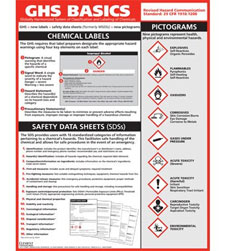
Ensure your workers are trained with safety posters and more from Safety Emporium.
(f)(1)(i)
(f)(1)(ii)
(f)(1)(iii)
(f)(1)(iv)
(f)(1)(v)
Precautionary statement(s); and,
(f)(1)(vi)
Name, address, and telephone number of the chemical manufacturer, importer, or other responsible party.
(f)(2)
The chemical manufacturer, importer, or distributor shall ensure that the information provided under paragraphs (f)(1)(i) through (v) is in accordance with Appendix C, Allocation of Label Elements, for each hazard class and associated hazard category for the hazardous chemical, prominently displayed, and in English (other languages may also be included if appropriate).
(f)(3)
The chemical manufacturer, importer, or distributor shall ensure that the information provided under paragraphs (f)(1)(ii) through (iv) is located together on the label, tag, or mark.
(f)(4)
Solid materials
(f)(4)(i)
For solid metal (such as a steel beam or a metal casting), solid wood, or plastic items that are not exempted as articles due to their downstream use, or shipments of whole grain, the required label may be transmitted to the customer at the time of the initial shipment, and need not be included with subsequent shipments to the same employer unless the information on the label changes;
(f)(4)(ii)
The label may be transmitted with the initial shipment itself, or with the safety data sheet that is to be provided prior to or at the time of the first shipment; and,
(f4)(iii)
This exception to requiring labels on every container of hazardous chemicals is only for the solid material itself, and does not apply to hazardous chemicals used in conjunction with, or known to be present with, the material and to which employees handling the items in transit may be exposed (for example, cutting fluids or pesticides in grains).
(f)(5)
Chemical manufacturers, importers, or distributors shall ensure that each container of hazardous chemicals leaving the workplace is labeled, tagged, or marked in accordance with this section in a manner which does not conflict with the requirements of the Hazardous Materials Transportation Act (49 U.S.C. 1801 et seq.) and regulations issued under that Act by the Department of Transportation./p>
(f)(6)
Workplace labeling. Except as provided in paragraphs (f)(7) and (f)(8) of this section, the employer shall ensure that each container of hazardous chemicals in the workplace is labeled, tagged or marked with either:
(f)(6)(i)
The information specified under paragraphs (f)(1)(i) through (v) for labels on shipped containers; or,
(f)(6)(ii)
Product identifier and words, pictures, symbols, or combination thereof, which provide at least general information regarding the hazards of the chemicals, and which, in conjunction with the other information immediately available to employees under the hazard communication program, will provide employees with the specific information regarding the physical and health hazards of the hazardous chemical.
(f)(7)
The employer may use signs, placards, process sheets, batch tickets, operating procedures, or other such written materials in lieu of affixing labels to individual stationary process containers, as long as the alternative method identifies the containers to which it is applicable and conveys the information required by paragraph (f)(6) of this section to be on a label. The employer shall ensure the written materials are readily accessible to the employees in their work area throughout each work shift.

NFPA signs and kits are available at Safety Emporium.
(f)(8)
The employer is not required to label portable containers into which hazardous chemicals are transferred from labeled containers, and which are intended only for the immediate use of the employee who performs the transfer. For purposes of this section, drugs which are dispensed by a pharmacy to a health care provider for direct administration to a patient are exempted from labeling.
(f)(9)
The employer shall not remove or deface existing labels on incoming containers of hazardous chemicals, unless the container is immediately marked with the required information.
(f10)
The employer shall ensure that workplace labels or other forms of warning are legible, in English, and prominently displayed on the container, or readily available in the work area throughout each work shift. Employers having employees who speak other languages may add the information in their language to the material presented, as long as the information is presented in English as well.
(f)(11)
Chemical manufacturers, importers, distributors, or employers who become newly aware of any significant information regarding the hazards of a chemical shall revise the labels for the chemical within six months of becoming aware of the new information, and shall ensure that labels on containers of hazardous chemicals shipped after that time contain the new information. If the chemical is not currently produced or imported, the chemical manufacturer, importer, distributor, or employer shall add the information to the label before the chemical is shipped or introduced into the workplace again.
[Beginning of This Section] [Top of this page]
For further information see:
Appendices to this document, 29 CFR 1910.1200.
- Appendix A - Health Hazard Criteria (Mandatory)
- Appendix B - Physical Criteria (Mandatory)
- Appendix C - Allocation of Label Elements
- Appendix F - Guidance for hazard classifications Re: Carcinogenicity (Non-Mandatory)
CPL 02-02-079, Inspection Procedures for the Hazard Communication Standard (HCS 2012)
- Scope and Application of paragraph (f).
- Inspection guidelines for paragraph (f).
- Citation guidelines for paragraph (f).
(g)(1)
Chemical manufacturers and importers shall obtain or develop a safety data sheet for each hazardous chemical they produce or import. Employers shall have a safety data sheet in the workplace for each hazardous chemical which they use.
(g)(2)
The chemical manufacturer or importer preparing the safety data sheet shall ensure that it is in English (although the employer may maintain copies in other languages as well), and includes at least the following section numbers and headings, and associated information under each heading, in the order listed (See Appendix D to § 1910.1200 - Safety Data Sheets, for the specific content of each section of the safety data sheet):
(g)(2)(i)
Section 1, Identification;
(g)(2)(ii)
Section 2, Hazard(s) identification;
(g)(2)(iii)
Section 3, Composition/information on ingredients;
(g)(2)(iv)
Section 4, First-aid measures;
(g)(2)(v)
Section 5, Fire-fighting measures;
(g)(2)(vi)
Section 6, Accidental release measures;
(g)(2)(vii)
Section 7, Handling and storage;
(g)(2)(viii)
Section 8, Exposure controls/personal protection;
(g)(2)(ix)
Section 9, Physical and chemical properties;
(g)(2)(x)
Section 10, Stability and reactivity;
(g)(2)(xi)
Section 11, Toxicological information;
(g)(2)(xii)
Section 12, Ecological information;
(g)(2)(xiii)
Section 13, Disposal considerations;
(g)(2)(xiv)
Section 14, Transport information;
(g)(2)(xv)
Section 15, Regulatory information; and
(g)(2)(xvi)
Section 16, Other information, including date of preparation or last revision.
Note 1 to paragraph (g)(2): To be consistent with the GHS, an SDS must also include the headings in paragraphs (g)(2)(xii) through (g)(2)(xv) in order.
Note 2 to paragraph (g)(2): OSHA will not be enforcing information requirements in sections 12 through 15, as these areas are not under its jurisdiction.
(g)(3)
If no relevant information is found for any sub-heading within a section on the safety data sheet, the chemical manufacturer, importer or employer preparing the safety data sheet shall mark it to indicate that no applicable information was found./p>
(g)(4)
Where complex mixtures have similar hazards and contents (i.e. the chemical ingredients are essentially the same, but the specific composition varies from mixture to mixture), the chemical manufacturer, importer or employer may prepare one safety data sheet to apply to all of these similar mixtures.
(g)(5)
The chemical manufacturer, importer or employer preparing the safety data sheet shall ensure that the information provided accurately reflects the scientific evidence used in making the hazard classification. If the chemical manufacturer, importer or employer preparing the safety data sheet becomes newly aware of any significant information regarding the hazards of a chemical, or ways to protect against the hazards, this new information shall be added to the safety data sheet within three months. If the chemical is not currently being produced or imported, the chemical manufacturer or importer shall add the information to the safety data sheet before the chemical is introduced into the workplace again.
(g)(6)
(g)(6)(i)
Chemical manufacturers or importers shall ensure that distributors and employers are provided an appropriate safety data sheet with their initial shipment, and with the first shipment after a safety data sheet is updated;
(g)(6)(ii)
The chemical manufacturer or importer shall either provide safety data sheets with the shipped containers or send them to the distributor or employer prior to or at the time of the shipment;
(g)(6)(iii)
If the safety data sheet is not provided with a shipment that has been labeled as a hazardous chemical, the distributor or employer shall obtain one from the chemical manufacturer or importer as soon as possible; and,
(g)(6)(iv)
The chemical manufacturer or importer shall also provide distributors or employers with a safety data sheet upon request.
(g)(7)
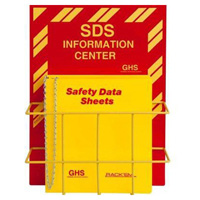
Your employees can stay informed and safety-ready with right to know stations and labels from Safety Emporium.
(g)(7)(i)
Distributors shall ensure that safety data sheets, and updated information, are provided to other distributors and employers with their initial shipment and with the first shipment after a safety data sheet is updated;
(g)(7)(ii)
The distributor shall either provide safety data sheets with the shipped containers, or send them to the other distributor or employer prior to or at the time of the shipment;
(g)(7)(iii)
Retail distributors selling hazardous chemicals to employers having a commercial account shall provide a safety data sheet to such employers upon request, and shall post a sign or otherwise inform them that a safety data sheet is available;
(g)(7)(iv)
Wholesale distributors selling hazardous chemicals to employers over-the-counter may also provide safety data sheets upon the request of the employer at the time of the over-the-counter purchase, and shall post a sign or otherwise inform such employers that a safety data sheet is available;
(g)(7)(v)
If an employer without a commercial account purchases a hazardous chemical from a retail distributor not required to have safety data sheets on file (i.e., the retail distributor does not have commercial accounts and does not use the materials), the retail distributor shall provide the employer, upon request, with the name, address, and telephone number of the chemical manufacturer, importer, or distributor from which a safety data sheet can be obtained;
(g)(7)(vi)
Wholesale distributors shall also provide safety data sheets to employers or other distributors upon request; and,
(g)(7)(vii)
Chemical manufacturers, importers, and distributors need not provide safety data sheets to retail distributors that have informed them that the retail distributor does not sell the product to commercial accounts or open the sealed container to use it in their own workplaces.
(g)(8)
The employer shall maintain in the workplace copies of the required safety data sheets for each hazardous chemical, and shall ensure that they are readily accessible during each work shift to employees when they are in their work area(s). (Electronic access and other alternatives to maintaining paper copies of the safety data sheets are permitted as long as no barriers to immediate employee access in each workplace are created by such options.)/p>
(g)(9)
Where employees must travel between workplaces during a workshift, i.e., their work is carried out at more than one geographical location, the material safety data sheets may be kept at the primary workplace facility. In this situation, the employer shall ensure that employees can immediately obtain the required information in an emergency./p>
(g)(10)
Safety data sheets may be kept in any form, including operating procedures, and may be designed to cover groups of hazardous chemicals in a work area where it may be more appropriate to address the hazards of a process rather than individual hazardous chemicals. However, the employer shall ensure that in all cases the required information is provided for each hazardous chemical, and is readily accessible during each work shift to employees when they are in their work area(s)./p>
(g)(11)
Safety data sheets shall also be made readily available, upon request, to designated representatives, the Assistant Secretary, and the Director, in accordance with the requirements of 29 CFR 1910.1020(e).
[Beginning of This Section] [Top of this page]
For further information see:
Appendices to this document, 29 CFR 1910.1200.
- Appendix D - Safety Data Sheets (Mandatory)
- Appendix F - Guidance for hazard classifications Re: Carcinogenicity (Non-Mandatory)
CPL 02-02-079, Inspection Procedures for the Hazard Communication Standard (HCS 2012)
- General requirements of paragraph (g)
- Requirements for employers for paragraph (g).
- Requirements for specific sections of the SDS for paragraph (g).
- Inspection procedures for paragraph (g).
- Citation guidelines for paragraph (g).
(h)(1)
Employers shall provide employees with effective information and training on hazardous chemicals in their work area at the time of their initial assignment, and whenever a new physical or health hazard the employees have not previously been trained about is introduced into their work area. Information and training may be designed to cover categories of hazards (e.g., flammability, carcinogenicity) or specific chemicals. Chemical-specific information must always be available through labels and safety data sheets.

Protect your workplace with portable and stationary eye washes and accessories from Safety Emporium.
(h)(2)
"Information." Employees shall be informed of:
(h)(2)(i)
The requirements of this section.
(h)(2)(ii)
hazardous chemicals are present; and,
(h)(2)(iii)
hazardous chemicals, and safety data sheets required by this section.
(h)(3)
Training." Employee training shall include at least:
(h)(3)(i)
Methods and observations that may be used to detect the presence or release of a hazardous chemical in the work area (such as monitoring conducted by the employer, continuous monitoring devices, visual appearance or odor of hazardous chemicals when being released, etc.).
(h)(3)(ii)
The physical, health, simple asphyxiant, combustible dust, and pyrophoric gas hazards, as well as hazards not otherwise classified, of the chemicals in the work area;
(h)(3)(iii)
The measures employees can take to protect themselves from these hazards, including specific procedures the employer has implemented to protect employees from exposure to hazardous chemicals, such as appropriate work practices, emergency procedures, and personal protective equipment to be used; and,
(h)(3)(iv)
The details of the hazard communication program developed by the employer, including an explanation of the labels received on shipped containers and the workplace labeling system used by their employer; the safety data sheet, including the order of information and how employees can obtain and use the appropriate hazard information.
[Beginning of This Section] [Top of this page]
For further information see:
Appendices to this document, 29 CFR 1910.1200.
- Training Requirements of paragraph (h)
- Inspection guidelines for paragraph (h).
- Citation guidelines for paragraph (h).
(i)(1)
The chemical manufacturer, importer, or employer may withhold the specific chemical identity, including the chemical name, other specific identification of a hazardous chemical, or the exact percentage (concentration) of the substance in a mixture, from the safety data sheet, provided that:
(i)(1)(i)
(i)(1)(ii)
Information contained in the safety data sheet concerning the properties and effects of the hazardous chemical is disclosed.
(i)(1)(iii)
The safety data sheet indicates that the specific chemical identity and/or percentage of composition is being withheld as a trade secret; and,
(i)(1)(iv)
The specific chemical identity and percentage is made available to health professionals, employees, and designated representatives in accordance with the applicable provisions of this paragraph (i).
(i)(2)
Where a treating physician or nurse determines that a medical emergency exists and the specific chemical identity and/or specific percentage of composition of a hazardous chemical is necessary for emergency or first-aid treatment, the chemical manufacturer, importer, or employer shall immediately disclose the specific chemical identity or percentage composition of a trade secret chemical to that treating physician or nurse, regardless of the existence of a written statement of need or a confidentiality agreement. The chemical manufacturer, importer, or employer may require a written statement of need and confidentiality agreement, in accordance with the provisions of paragraphs (i)(3) and (4) of this section, as soon as circumstances permit.
(i)(3)
In non-emergency situations, a chemical manufacturer, importer, or employer shall, upon request, disclose a specific chemical identity or percentage composition, otherwise permitted to be withheld under paragraph (i)(1) of this section, to a health professional (i.e. physician, industrial hygienist, toxicologist, epidemiologist, or occupational health nurse) providing medical or other occupational health services to exposed employee(s), and to employees or designated representatives, if:
(i)(3)(i)
The request is in writing.
(i)(3)(ii)
The request describes with reasonable detail one or more of the following occupational health needs for the information:
(i)(3)(ii)(A)
To assess the hazards of the chemicals to which employees will be exposed.
(i)(3)(ii)(B)
To conduct or assess sampling of the workplace atmosphere to determine employee exposure levels.
(i)(3)(ii)(C)
To conduct pre-assignment or periodic medical surveillance of exposed employees.
(i)(3)(ii)(D)
To provide medical treatment to exposed employees.
(i)(3)(ii)(E)
To select or assess appropriate personal protective equipment for exposed employees.
(i)(3)(ii)(F)
To design or assess engineering controls or other protective measures for exposed employees; and.
(i)(3)(ii)(G)
To conduct studies to determine the health effects of exposure.
(i)(3)(iii)
The request explains in detail why the disclosure of the specific chemical identity or percentage composition is essential and that, in lieu thereof, the disclosure of the following information to the health professional, employee, or designated representative, would not satisfy the purposes described in paragraph (i)(3)(ii) of this section:
(i)(3)(iii)(A)
The properties and effects of the chemical.
(i)(3)(iii)(B)
Measures for controlling workers' exposure to the chemical.
(i)(3)(iii)(C)
Methods of monitoring and analyzing worker exposure to the chemical; and,
(i)(3)(iii)(D)
Methods of diagnosing and treating harmful exposures to the chemical;
(i)(3)(iv)
The request includes a description of the procedures to be used to maintain the confidentiality of the disclosed information; and,
(i)(3)(v)
The health professional, and the employer or contractor of the services of the health professional (i.e. downstream employer, labor organization, or individual employee), employee, or designated representative, agree in a written confidentiality agreement that the health professional, employee, or designated representative, will not use the trade secret information for any purpose other than the health need(s) asserted and agree not to release the information under any circumstances other than to OSHA, as provided in paragraph (i)(6) of this section, except as authorized by the terms of the agreement or by the chemical manufacturer, importer, or employer.
(i)(4)
The confidentiality agreement authorized by paragraph (i)(3)(iv) of this section:
(i)(4)(i)
May restrict the use of the information to the health purposes indicated in the written statement of need;
(i)(4)(ii)
May provide for appropriate legal remedies in the event of a breach of the agreement, including stipulation of a reasonable pre-estimate of likely damages; and,
(i)(4)(iii)
(i)(5)
Nothing in this standard is meant to preclude the parties from pursuing non-contractual remedies to the extent permitted by law.
(i)(6)
If the health professional, employee, or designated representative receiving the trade secret information decides that there is a need to disclose it to OSHA, the chemical manufacturer, importer, or employer who provided the information shall be informed by the health professional, employee, or designated representative prior to, or at the same time as, such disclosure.
(i)(7)
If the chemical manufacturer, importer, or employer denies a written request for disclosure of a specific chemical identity, the denial must:
(i)(7)(i)
Be provided to the health professional, employee, or designated representative, within thirty days of the request;
(i)(7)(ii)
Be in writing;
(i)(7)(iii)
Include evidence to support the claim that the specific chemical identity is a trade secret;
(i)(7)(iv)
State the specific reasons why the request is being denied; and,
(i)(7)(v)
Explain in detail how alternative information may satisfy the specific medical or occupational health need without revealing the trade secret.
(i)(8)
The health professional, employee, or designated representative whose request for information is denied under paragraph (i)(3) of this section may refer the request and the written denial of the request to OSHA for consideration.
(i)(9)
When a health professional, employee, or designated representative refers the denial to OSHA under paragraph (i)(8) of this section, OSHA shall consider the evidence to determine if:
(i)(9)(i)
The chemical manufacturer, importer, or employer has supported the claim that the specific chemical identity or percentage composition is a trade secret;
(i)(9)(ii)
The health professional, employee, or designated representative has supported the claim that there is a medical or occupational health need for the information; and,
(i)(9)(iii)
The health professional, employee or designated representative has demonstrated adequate means to protect the confidentiality.
(i)(10)
(i)(10)(i)
If OSHA determines that the specific chemical identity or percentage composition requested under paragraph (i)(3) of this section is not a "bona fide" trade secret, or that it is a trade secret, but the requesting health professional, employee, or designated representative has a legitimate medical or occupational health need for the information, has executed a written confidentiality agreement, and has shown adequate means to protect the confidentiality of the information, the chemical manufacturer, importer, or employer will be subject to citation by OSHA.
(i)(10)(ii)
If a chemical manufacturer, importer, or employer demonstrates to OSHA that the execution of a confidentiality agreement would not provide sufficient protection against the potential harm from the unauthorized disclosure of a trade secret, the Assistant Secretary may issue such orders or impose such additional limitations or conditions upon the disclosure of the requested chemical information as may be appropriate to assure that the occupational health services are provided without an undue risk of harm to the chemical manufacturer, importer, or employer.
(i)(11)
If a citation for a failure to release trade secret information is contested by the chemical manufacturer, importer, or employer, the matter will be adjudicated before the Occupational Safety and Health Review Commission in accordance with the Act's enforcement scheme and the applicable Commission rules of procedure. In accordance with the Commission rules, when a chemical manufacturer, importer, or employer continues to withhold the information during the contest, the Administrative Law Judge may review the citation and supporting documentation "in camera" or issue appropriate orders to protect the confidentiality of such matters.
(i)(12)
Notwithstanding the existence of a trade secret claim, a chemical manufacturer, importer, or employer shall, upon request, disclose to the Assistant Secretary any information which this section requires the chemical manufacturer, importer, or employer to make available. Where there is a trade secret claim, such claim shall be made no later than at the time the information is provided to the Assistant Secretary so that suitable determinations of trade secret status can be made and the necessary protections can be implemented.
(i)(13)
Nothing in this paragraph shall be construed as requiring the disclosure under any circumstances of process information which is a trade secret.
[Beginning of This Section] [Top of this page]
For further information see:
Appendices to this document, 29 CFR 1910.1200.
- Appendix E - Definition of "Trade Secret" (Mandatory)
CPL 02-02-079, Inspection Procedures for the Hazard Communication Standard (HCS 2012)
- Scope and Application of paragraph (i)
- Inspection guidelines for paragraph (i).
- Citation guidelines for paragraph (i).
(j)(1)
Employers shall train employees regarding the new label elements and safety data sheets format by December 1, 2013.
(j)(2)
Chemical manufacturers, importers, distributors, and employers shall be in compliance with all modified provisions of this section no later than June 1, 2015, except:
(j)(2)(i)
After December 1, 2015, the distributor shall not ship containers labeled by the chemical manufacturer or importer unless the label has been modified to comply with paragraph (f)(1) of this section.
(j)(2)(ii)
All employers shall, as necessary, update any alternative workplace labeling used under paragraph (f)(6) of this section, update the hazard communication program required by paragraph (h)(1), and provide any additional employee training in accordance with paragraph (h)(3) for newly identified physical or health hazards no later than June 1, 2016.
(j)(3)
Chemical manufacturers, importers, distributors, and employers may comply with either § 1910.1200 revised as of October 1, 2011, or the current version of this standard, or both during the transition period.
For further information see:
CPL 02-02-079, Inspection Procedures for the Hazard Communication Standard (HCS 2012)
- Appendix E - HCS Effective Dates.
[59 FR 17479, April 13, 1994; 59 FR 65947, Dec. 22, 1994; 61 FR 5507, Feb. 13, 1996; 77 FR 17785, March 26, 2012]
* Accessibility Assistance: Contact the OSHA Directorate of Standards and Guidance at 202-693-1950 for assistance accessing PDF materials.
[78 FR 9313, Feb. 8, 2013]
[Document index (top of page)]
The official, public domain, OSHA version of this document is available at https://www.osha.gov/laws-regs/regulations/standardnumber/1910/1910.1200.
